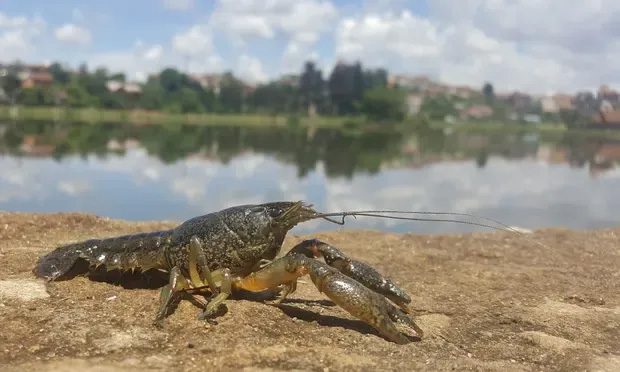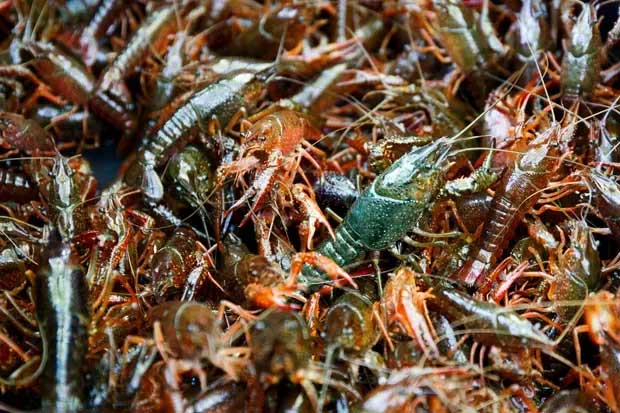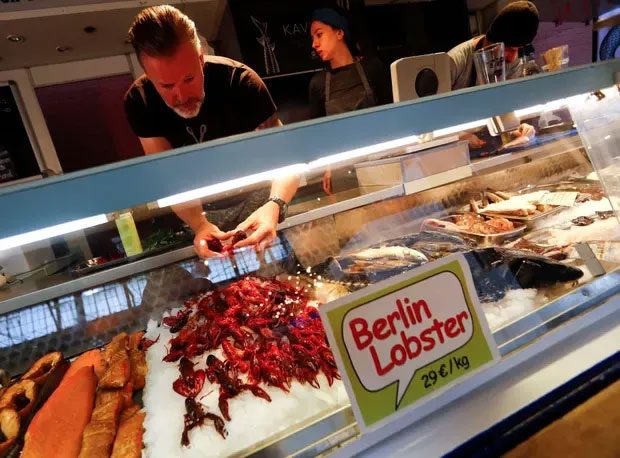If you come across a small, grayish-blue shrimp with mottled patterns, congratulations, you have encountered the marbled crayfish, a creature that has become a nightmare for Germany. This freshwater crustacean has attracted scientific attention in recent years due to its asexual reproduction in females and its rapid adaptability, making it one of the most dangerous invasive species.
The marbled crayfish was first recognized in 1995 when a biology student purchased a bag of crayfish advertised as Texas crayfish. However, after a while, the small bag of crayfish reproduced uncontrollably, leading him to distribute them to friends to release into rivers, lakes, and toilets. This unintentional act transformed Germany, much of continental Europe, and especially Madagascar—home to a unique freshwater ecosystem—into a second home for this species.

Marbled crayfish.
When Frank Lyko, a professor of epigenetics at the German Cancer Research Center (DKFZ), first encountered this crayfish, he was astonished by their ability to reproduce from a single cell and decided to make them the subject of his research.
“All marbled crayfish share the same genetic makeup, yet they adapt quickly to various environments. This makes them scientifically significant, much like a tumor that adapts to its surroundings,” he stated.
Lyko led an ambitious study on their genome and confirmed that all marbled crayfish originated from a single female. They reproduce asexually through parthenogenesis. In 2015, the professor classified this all-female crustacean species as Procambarus virginalis.
The More You Eat, the Better
In Germany, where the invasion of marbled crayfish is a pressing issue, authorities have adopted a strict approach. Specifically, the environmental department of the Berlin Senate tasked Klaus Hidde, a retired banker and now an avid angler, with trapping the crayfish. He noted that marbled crayfish not only threaten native species but also cause crayfish plague—disease that wiped out the European crayfish market 150 years ago.
Previously, Hidde had a similar task with red crayfish. “In just one year, I caught 42,000 of them. I was seen as a savior,” he remarked. Berlin restaurants have taken on the role of transforming red crayfish into a popular dish among Germans.
However, the marbled crayfish market is not as lucrative as that of red crayfish. Hidde explained that officials remain cautious about creating a demand for the meat of this self-replicating species, which could lead to over-reproduction and worsen the situation.

This species is extremely dangerous to the native ecosystem.
Meanwhile, Lukas Bosch, co-founder of Holycrab!, a biodiversity startup, hopes the nutritional value of marbled crayfish can attract Germans seeking sustainable food alternatives. The company plans to transform invasive species—such as raccoon dogs, Egyptian geese, wild boars, and crustaceans like Chinese mitten crabs—into delicious dishes while raising awareness about the ecosystem among German diners.
The company has experimented with selling marbled crayfish meat in sandwiches, as well as preparing the high-protein animals in stews and braises. “Since these crayfish have no natural predators, we thought, why not let humans fill that role? Instead of discarding the meat, in this case, the more we consume, the better,” he said.
Learning to Coexist
Ranja Adriantsoa, a conservation biologist, stated that this species is extremely dangerous to the native ecosystem. A female crayfish about 12 cm long can carry between 200 to 700 eggs, and since it reproduces four times a year without mating, it doesn’t take long to create a population of several million genetically identical individuals.
When Adriantsoa first worked for the invasive species control department at the University of Antananarivo in Madagascar’s capital, her team aimed to prevent the spread of marbled crayfish. She was made aware of their potential to devastate ecosystems, preying on fish larvae, displacing native crayfish, and destroying the country’s staple crop—rice.
“Over time, however, things have gradually changed. No matter how much effort is made, it must be acknowledged that this species has had enough time to turn any place it arrives into a new home. We must find a way to coexist with them,” she said.
Together with conservation scientist Julia Jones—a professor at Bangor University in Wales—Adriantsoa and a group of international female scientists launched the “Perfect Invader” project to study the impact of this species on humans. According to their findings, marbled crayfish could provide a source of high-quality, affordable protein for Malagasy people—one of the poorest countries in the world, where approximately 42% of children are stunted.

Marbled crayfish could be a source of high-quality protein.
The research also explored their potential in addressing the spread of schistosomiasis, which affects nearly 290 million people worldwide, including millions in Madagascar. The hope is that this crayfish will consume freshwater snails, which are hosts to the parasitic flatworms that cause acute and chronic disease.
Additionally, working with Germany’s largest research institute, the Helmholtz Association, Lyko is involved in a project to convert the shells of marbled crayfish—rich in chitin, a biopolymer—into biodegradable plastic. The project is expected to release details this month.
According to Jones, this species teaches her and other scientists to look at the bigger picture. “On one hand, we need to understand the negative ecological impacts of marbled crayfish in Madagascar, but on the other hand, we cannot avoid learning how to live smartly alongside this invasive crayfish. It’s there and cannot be removed,” she stated.
At the same time, she emphasized the importance of preventing the spread of marbled crayfish to other areas. They are banned in the EU and the UK, but some believe that a few individuals may be illegally farming them.
“They are spreading rapidly—they are already in Poland and will eventually be in the UK. I think marbled crayfish will soon add their name to the list of the most frightening invasive species alongside zebra mussels, cane toads, and gray wolves,” Jones remarked.





















































